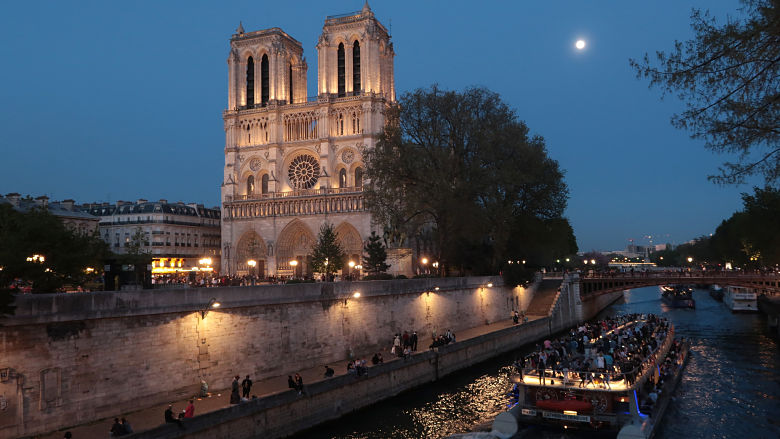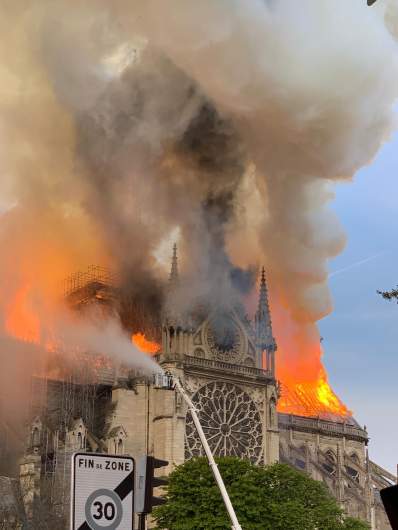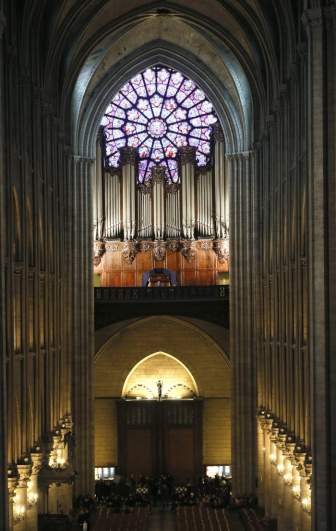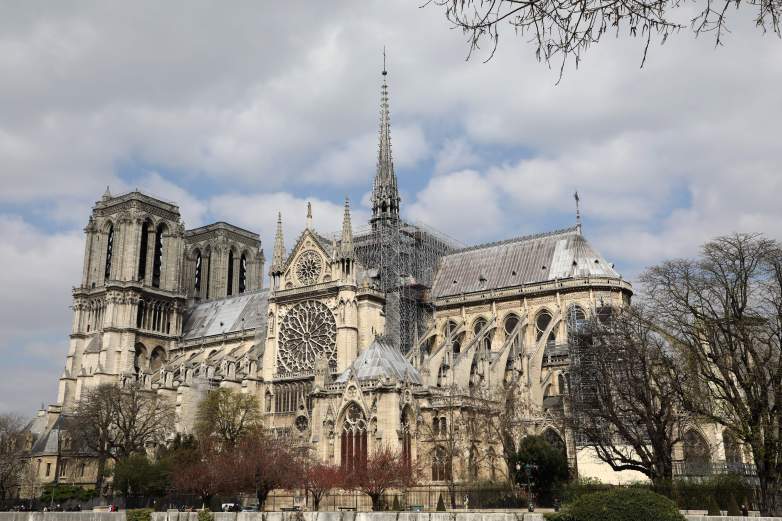
Getty
The Notre Dame Cathedral in Paris, France, caught fire on Monday, April 15. As The Guardian reports, authorities believe that the fire was caused by an accident related to the restoration work that had been ongoing.
Flames and billowing smoke was seen from miles away as thousands of people gathered around the famous Parisian landmark. At one point, the crowd broke out into a beautifully heartbreaking version of Ave Maria.
Construction began on the cathedral, located on Île de la Cité in the middle of the Seine River, in 1163. The medieval, Gothic structure was built over the course of hundreds of years and wasn’t completed until 1345. The cathedral stands 130 meters long, 48 meters wide, and 35 meters high.
Here’s what you need to know:
1. This Isn’t the First Time That a Fire Has Broken Out in Notre Dame Cathedral’s History

GettyFlames and smoke are seen billowing from the roof at Notre-Dame Cathedral in Paris on April 15, 2019.
The fire that broke out on Monday was not the first of its kind. In fact, a fire broke out in the 13th century, causing major damage and requiring a renovation. This fire was written about in the book, The Engineering of Medieval Catherdrals. The cathedral saw massive refurbishments following the fire and was restored between 1230 and 1240.
Monday’s fire has destroyed several areas of the cathedral, including its roof.
“The roof that caught fire is original, made of 5,000 oak trees. The medieval spire, which collapsed on Monday, was removed in 1786 because it wasn’t stable, then rebuilt during the 1860s, in a design conceived by Eugène-Emmanuel Viollet-le-Duc, when Napoleon III was in power,” Time reports.
France’s president, Emmanuel Macron, has plans to “rebuild together.” According to CNN, fundraising efforts have netted hundreds of millions of dollars. While the financial aspect of the rebuild seems to be taken care of, the process is expected to be lengthy.
“It’s already a wet building because of the water that’s been pumped on it, so they’re going to need to provide some kind of cover from the elements. The roof’s job was to discharge thousands of tons of water, so where’s that going to go? Every time it rains it’s going to cause damage at this point, so it’s against a war of attrition now,” architectural historian and broadcaster Jonathan Foyle told CNN by phone.
2. The Cathedral Had Been Undergoing a Massive Renovation

Notre Dame Cathedral had been undergoing a massive renovation, with a hefty price tag of $180 million. Over the years, the cathedral had been damaged and was in need of restoration.
The crumbling limestone and other major architectural flaws have been blamed on normal wear over time and the effects of the weather.
“Everywhere the stone is eroded, and the more the wind blows, the more all of these little pieces keep falling,” André Finot, a spokesperson for the cathedral, previously told The New York Times.
“There is a real need for urgent restoration work,” said Michel Picaud.
This was not the first time that Notre Dame underwent a facelift. In 1844, for example, architects Jean-Baptiste-Antoine Lassus and Eugène Emmanuel Viollet-le-Duc took on a project that saw the spire and the flying buttresses refurbished. Over the years, other updates have been made to the structure’s windows, bells, and more.
3. The Name ‘Notre Dame’ Translates to ‘Our Lady’

GettyA view of the grand organ inside the Notre-Dame de Paris cathedral on November 30, 2012, in Paris.
Notre Dame is French for “Our Lady” and refers to the Virgin Mary.
The cathedral is used by the Roman Catholic Church for Sunday mass each week and is the seat of the Archbishop of Paris, Michel Christian Alain Aupetit, who has held the position since January 2018, according to a website dedicated to information about the cathedral.
“A notable and distinct historical artifact which is very popular today is the famous bell that has been redesigned to ring automatically. Any visitor to the bell tower should be prepared to climb the 140 steps staircase, if desirous of seeing the historical bell or have a glimpse of the city of Paris. Also inside the Notre Dame Cathedral, among so many historical artifacts, is the notable 17th-century organ with all of its parts still functional. There are also drawings, plans, and engravings which showed the old and hidden mysteries of several of the church developments and how the city of Paris came into being.”
4. The Structure Was Designed by Maurice de Sully

Notre Dame Cathedral replaced a church that had previously been located on the island. According to The New York Times, the church that previously stood was destroyed by a fire before Notre Dame was built.
Shortly after it was erected, the cathedral was deemed too small for worshippers. An expansion was in order and Maurice de Sully was the man primarily behind the design, according to Time.
“He personally selected leading artists and chose the subjects of the complex iconography. And he took fresh architectural gambles. The ceiling of Notre–Dame rises higher (107 feet) than any other cathedral then built because Bishop Sully trusted the strength of the relatively untested ribbed vault; Sully’s second master builder was one of the first to develop the flying buttress,” Time previously reported.
5. It’s a Popular Tourist Destination That Attracts Approximately 13 Million People Each Year
Notre Dame Cathedral is a Catholic church that serves as one of Paris’ most visited landmarks. It is a popular tourist destination, with an estimated 13 million people visiting each year.
Entrance to the cathedral is free. It opens every day at 8 a.m. local time.
Many celebrities, like Vanderpump Rules star Stassi Schroeder, pictured above, put the cathedral on their list of “places to visit” when in Paris.
